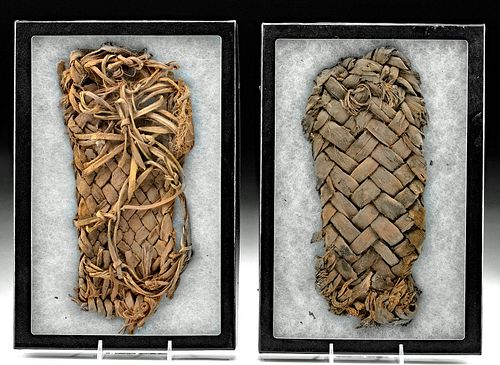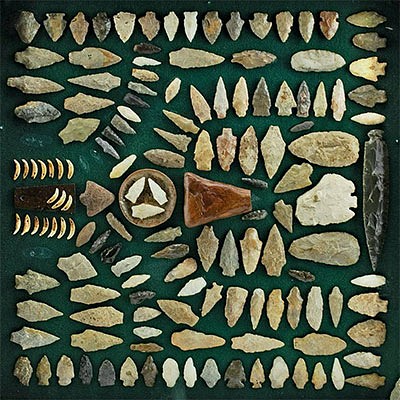2 Rare Anasazi Woven Yucca Fiber Sandals
Lot 43
About Seller
Artemis Gallery
686 S Taylor Ave, Ste 106
Louisville, CO 80027
United States
Selling antiquities, ancient and ethnographic art online since 1993, Artemis Gallery specializes in Classical Antiquities (Egyptian, Greek, Roman, Near Eastern), Asian, Pre-Columbian, African / Tribal / Oceanographic art. Our extensive inventory includes pottery, stone, metal, wood, glass and textil...Read more
Estimate:
$1,200 - $1,800
Absentee vs Live bid
Two ways to bid:
- Leave a max absentee bid and the platform will bid on your behalf up to your maximum bid during the live auction.
- Bid live during the auction and your bids will be submitted real-time to the auctioneer.
Bid Increments
| Price | Bid Increment |
|---|---|
| $0 | $25 |
| $300 | $50 |
| $1,000 | $100 |
| $2,000 | $250 |
| $5,000 | $500 |
| $10,000 | $1,000 |
| $20,000 | $2,500 |
| $50,000 | $5,000 |
| $100,000 | $10,000 |
| $200,000 | $20,000 |
About Auction
By Artemis Gallery
Apr 28, 2022
Set Reminder
2022-04-28 12:00:00
2022-04-28 12:00:00
America/New_York
Bidsquare
Bidsquare : Art & Artifacts of North America
https://www.bidsquare.com/auctions/artemis-gallery/art-artifacts-of-north-america-9276
Join us for a special auction not to be missed! Collectible Native American art from two major collectors. Antiquity to mid-20th century! Plus fine & folk art, fossils, and more! All legally acquired. All legal to buy/sell. Convenient and professional in-house shipping. Artemis Gallery info@artemisgallery.com
Join us for a special auction not to be missed! Collectible Native American art from two major collectors. Antiquity to mid-20th century! Plus fine & folk art, fossils, and more! All legally acquired. All legal to buy/sell. Convenient and professional in-house shipping. Artemis Gallery info@artemisgallery.com
- Lot Description
Native American, Southwestern United States, Utah, San Juan County, Montezuma Creek Canyon, Anasazi (Ancestral Puebloan), ca. 1200 to 1350 CE. A wonderful set of 2 hand-built sandals woven from thick yucca plant fronds. The base of each shoe is formed from thick, zigzagging frond strips to absorb the weight of each step, and the top of one sandal still retains its original ankle and foot bindings. Yucca leaves were used either whole, split, or separated, and sometimes they were shredded and spun into cordage. Most often the yucca was woven whole into the sandal's sole as seen here. Ties and loops were added to secure the sandal to the wearer's feet. The fine interlacing exemplified here demonstrates the Anasazi weavers' skills as textile artists. A rare glimpse into ancient footwear that has been remarkably well preserved. Shoes not only protected the feet but also acted as status symbols. Size of each (both are relatively similar): 10.25" L x 4.5" W (26 cm x 11.4 cm); (Riker boxes): 12.3" L x 8.3" W (31.2 cm x 21.1 cm)
Provenance: private South Carolina, USA collection
All items legal to buy/sell under U.S. Statute covering cultural patrimony Code 2600, CHAPTER 14, and are guaranteed to be as described or your money back.
A Certificate of Authenticity will accompany all winning bids.
PLEASE NOTE: Due to recent increases of shipments being seized by Australian & German customs (even for items with pre-UNESCO provenance), we will no longer ship most antiquities and ancient Chinese art to Australia & Germany. For categories of items that are acceptable to ship to Australia or Germany, please contact us directly or work with your local customs brokerage firm.
Display stands not described as included/custom in the item description are for photography purposes only and will not be included with the item upon shipping.
#171338Loss to ankle and foot bindings for one sandal as shown, and losses to some peripheral fibers as well as portions of ankle and foot bindings to the other sandal. Both pieces have fraying, minor loosening to some fibers, and expected desiccation commensurate with age as well as thick mud deposits. Great preservation to overall forms. We do not recommend wearing these.Condition
- Shipping Info
-
All shipping is handled in-house for your convenience. Your invoice from Artemis Gallery will include shipping calculation instructions. If in doubt, please inquire BEFORE bidding for estimated shipping costs for individual items.
-
- Buyer's Premium



 EUR
EUR CAD
CAD AUD
AUD GBP
GBP MXN
MXN HKD
HKD CNY
CNY MYR
MYR SEK
SEK SGD
SGD CHF
CHF THB
THB












